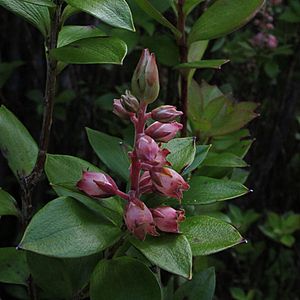Archeria racemosa facts for kids
Quick facts for kids Archeria racemosa |
|
|---|---|
 |
|
| Scientific classification | |
| Genus: |
Archeria (plant)
|
| Species: |
racemosa
|
The Archeria racemosa is a cool type of shrub, which is like a big bush. It belongs to the Ericaceae family, which also includes plants like blueberries and rhododendrons!
Contents
Where Does Archeria racemosa Live?
This special shrub is only found in New Zealand, which means it's endemic there. You can find it scattered in a few northern spots. These include Little Barrier Island, Great Barrier Island, the Coromandel Peninsula, and from the Bay of Plenty over to East Cape.
What is its Habitat Like?
Archeria racemosa mostly grows in shrubland areas and at the edges of forests. It likes places from lowland areas up to montane (mountainous) altitudes.
When Does it Flower and Fruit?
- Its beautiful flowers bloom from December to January.
- The plant then produces fruits from February to April.
What Does Archeria racemosa Look Like?
Its Overall Shape
This plant is an shrub that stands upright. It can grow up to 5 meters (about 16 feet) tall, but it's often shorter. It has branches that spread out, and its leaves tend to grow in bunches at the ends of these branches. The bark on its stems is a dark brown or even black color.
Its Leaves
The leaves of Archeria racemosa are broad and feel leathery. They are shaped like an oval or a long ellipse, and often have sharp tips. The base of the leaf is stiff and attaches very closely to the stem with a short, flat stalk called a petiole.
- The leaves are usually about 25–40 millimeters (1 to 1.5 inches) long.
- They are about 8–12 millimeters (0.3 to 0.5 inches) wide.
- The edges of the leaves are smooth and flat, or sometimes slightly curved downwards.
- You might see clear lines (like veins) on the underside of some leaves, but they can be hard to see on others.
- If you crush the leaves, they sometimes have a strong, sharp smell.
Its Flowers
The flowers grow in a single cluster at the end of a branch. This cluster is called a raceme, and it has about 10 to 20 (sometimes up to 30) flowers. The whole cluster is usually 25–45 millimeters (1 to 1.7 inches) long.
- The flowers are small and shaped like an urn.
- They can be white to bright pink. Often, they are lighter at the bottom and get darker towards the tips of the petals.
- The sepals (small leaf-like parts protecting the bud) are almost separate and about 2–3 millimeters long.
- The main part of the flower (the corolla) is about 6 millimeters long. The tube part is 4 millimeters, and the petal-like lobes are 2 millimeters.
- Inside, the ovary (where seeds develop) has 5 deep sections, and it has a strong, lasting style (a part of the female reproductive organ).
Its Fruits
The fruits are small capsules, about 2–3 millimeters across. They are roundish and have 3 to 5 sections inside where the seeds are.
- Sometimes, during years with lots of flowers, a different type of flower has been seen.
- These are shorter, more upright clusters of light yellow male flowers.
How Did Archeria racemosa Evolve?
Scientists are still learning about the family tree (or phylogeny) of the Archeria genus. However, based on how it looks, A. racemosa seems to be most similar to A. traversii. This is the only other species from the Archeria genus found in New Zealand.
Is Archeria racemosa Endangered?
Currently, Archeria racemosa is considered "naturally uncommon." This means it's not found everywhere, but it's not seen as threatened or in danger of disappearing.
How Did it Get its Name?
The name Archeria was given by a famous botanist named Joseph Dalton Hooker in 1844. He named it after W. Archer, a botanist from Tasmania who lived in the 1800s. The second part of its name, "racemosa," refers to how its flowers grow in raceme clusters. Hooker also gave it this specific name in 1864.

